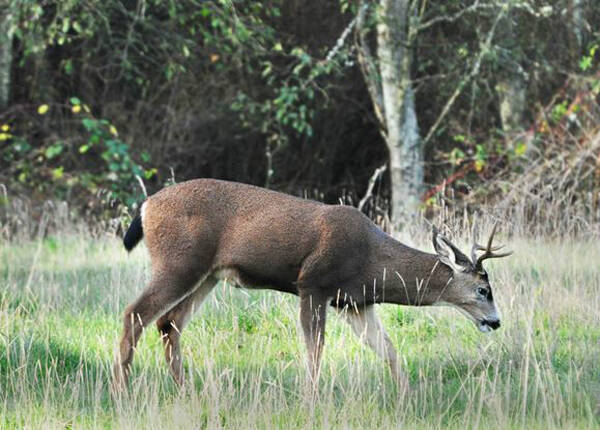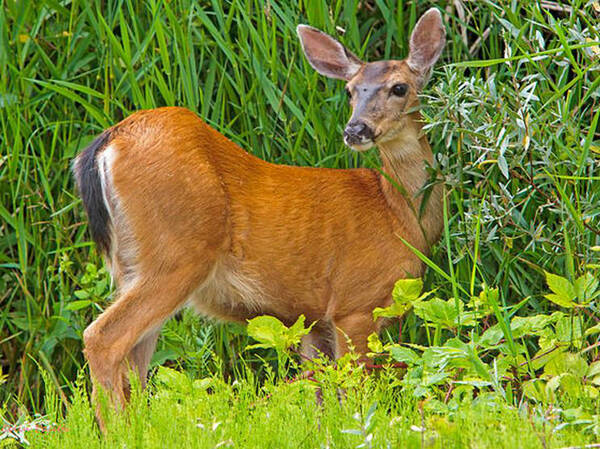Odocoileus hemionus
IUCN
LCBasic Information
Scientific classification
- name:Odocoileus hemionus
- Scientific Name:Odocoileus hemionus,Mule Deer、Black-tailed Deer、Cedros Island Mule Deer、Cedros Island Black-tailed Deer
- Outline:Ungulata
- Family:Artiodactyls Cervidae Odontodon
Vital signs
- length:1-1.9m
- Weight:50-215kg
- lifetime:10-25years
Feature
It is named after its mule-like ears.
Distribution and Habitat
Distributed in Canada (Alberta, British Columbia, Manitoba, Northwest Territories, Yukon); Mexico (Baja California, Chihuahua, Coahuila, Nuevo León, Sonora, Tamaulipas); United States (Alaska, Arizona, California, Colorado, Hawaii Island - introduced, Idaho, Iowa, Kansas, Montana, Nebraska, Nevada, New Mexico, North Dakota, Oklahoma, Oregon, South Dakota, Texas, Utah, Washington, Wyoming).
Introduced: Argentina.
Inhabits a variety of environments such as cold and temperate grasslands, forests, hills and even deserts, and has successfully adapted to extremely harsh dry heat and intense cold, meager forage, lack of water and deserts lacking plant growth. Can live in deserts and semi-arid areas.
Appearance
The shoulder height is 90-105 cm, the body length is 1-1.9 meters, the tail length is 10-25 cm, the weight is 50-215 kg, and the ears are 23 cm long. Their ears are particularly long, like the ears of a mule. Only male deer have horns. The horns have a distinct trunk. The forks of the horns are separated from the trunk and divided into 5-8 forks, slightly curved inward, about 7.8-1 meters long, the horn rack tends to be wide and lacks a sharp fork at the top. The eye sockets are sunken, with facial glands; there are foot glands; there is no gallbladder. The stomach has 4 chambers and ruminates. There are 32 teeth (the tooth order is I (incisors) 0/3, C (canines) 0/1, Pm (premolars) 3/3, M (molars) 3/3 X 2 = 32). The legs are slender and good at running. The horns are the second characteristic of male deer, and they are also weapons for competing for mates. Their growth and shedding are affected by the pituitary gland and testosterone. The first horns born at the age of 1-2 are almost s
Details
Mule Deer (scientific name: Odocoileus hemionus) is also known as Mule Deer, Black-tailed Deer, Cedros Island Mule Deer, Cedros Island Black-tailed Deer, and has 11 subspecies. It is named after its mule-like ears and is also called black-tailed deer.

Mule deer are like nomads, following water and grass, and like to rest near water and food. In summer, they are often seen in the 3,000-meter alpine grasslands. In addition to herbs, mule deer also like to eat various wild berries such as blackberries and blueberries. They are most active at dawn and dusk, wandering around, and resting in secluded places during the day.
Mule deer are herbivores. Their food includes green plants, branches, bark, buds, fruits, nuts, grass, leaves, seeds, fungi, lichens, etc., but their digestive capacity is limited and their nutrient absorption rate is relatively low. Therefore, mule deer have a very high food intake. In autumn, they will eat desperately to accumulate fat for the winter.

Mule deer have strong adaptability. In the non-breeding season, males and females live in groups of 3-4 heads each. In winter, they form large groups of hundreds of deer. They are nocturnal, active in the early morning and dusk, and rest in the shade at noon. They are good at swimming and can swim across 6-14 kilometers of water. They have seasonal migration habits. It runs on four legs and can reach 7 meters in one step. Its natural enemies include brown bears, black bears, mountain lions, wolves, coyotes, wolverines, bobcats, and Canadian lynxes, but it is not easy to catch it. In addition to its sharp vision, hearing, and sense of smell, the mule deer can run at a speed of 45-58 kilometers per hour and can easily jump over a 5-7 meter wide ditch or a 2 meter high steep slope.
Mule deer mate from October to December each year, and some populations may delay until January or February of the following year. The marriage is not monogamous or polygamous. Female deer can be intimate with multiple male deer, and occasionally fall in love with their relatives, white-tailed deer. Male deer and female deer usually move in groups, and they only walk together during the courtship period in autumn. Female deer will be in estrus for a few days during this season. Male deer will smell the time is ripe. During the estrus period, male deer will fight each other for mates, and from time to time they will use their antlers to fight with their opponents. Only the strong male deer can win the right to mate. Once the mating period is over, the male deer's antlers will fall off in winter, and new antlers will grow immediately to prepare for the new year's courtship season. Interestingly, if the female deer fails to conceive, she will enter the estrus cycle again within a month.
The gestation period of female deer is about 6-7 months, and the fawns are born in the spring of the following year. The delivery time is delayed by 7 days for every 305 meters increase in average altitude, depending on the geographical population. Each litter has 1-2 fawns. At this time, the earth wakes up and there are green grass and tender leaves everywhere to eat. The fawns stick to their mothers for two or three months, spending the summer together. In autumn, they are weaned and learn to eat various plants from their mothers. Newborn fawns are covered with white spots like sika deer. After birth, they instinctively lie down in dense grass to hide from enemies. After being cared for by the female deer for a few days, they can eat solid food. They can move freely when they are three weeks old, and can follow the group to roam around when they are one month old. The white spots fade when they are two months old. The lactation period is 2-4 months. Females reach sexual maturity at 1-2 years old, and males at 3-4 years old. The life span is 10-20 years, with the highest record being 25 years.

The most pressing threats to the survival of mule deer in the wild today are the spread of chronic wasting disease (CWD) and transmissible spongiform encephalopathy (TSE). CWD is more prominent at the local or regional level. CWD has been diagnosed as a major threat to mule deer in the Rocky Mountain region of the United States and other Midwestern states. Other threats include: high predatory populations of natural enemies (including wild dogs), livestock grazing, changes in human settlements and competition from other human forces. Although most subspecies are not threatened, the Mule Deer Island subspecies is in a vulnerable state of survival due to its small number and high predation by wild dogs and poaching (IUCN1988).
Due to the strong adaptability of mule deer and the high survival rate of young, the current population is still very large, about 130,000 to 170,000 heads. Therefore, there is no relevant protection law. It is an important target of the hunting industry in Canada and the United States. Moreover, this deer has become rampant in some areas with fewer natural enemies, seriously damaging the growth of local vegetation and crops.
Listed in the "Red List of Endangered Species of the World Conservation Union" (IUCN) 2015 ver 3.1-Least Concern (LC).
Protect wild animals and stop eating game.
Maintaining ecological balance is everyone's responsibility!








